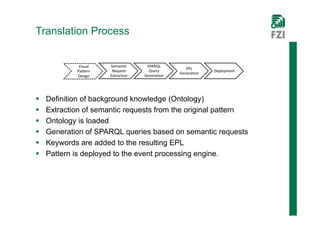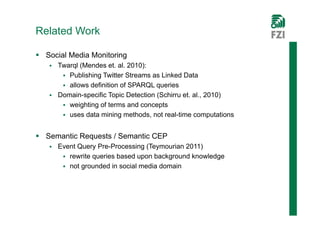Using Complex Event Processing for Modeling Semantic Requests in Real-Time Social Media Monitoring
- 1. INFORMATIK Using Complex Event Processing for Modeling FZI FORSCHUNGSZENTRUM Semantic Requests in Real-Time Social Media Monitoring Dominik Riemer, Nenad Stojanovic, Ljiljana Stojanovic FZI Research Center for Information Technologies, Karlsruhe, Germany RAMSS 2012, 04 June 2012 Dublin, Ireland
- 2. Agenda Introduction Use Cases System Architecture Semantic Requests Tools Discussion
- 3. INTRODUCTION
- 4. Why is Social Media Monitoring important? Social Media Monitoring Continuous process of monitoring a specific subject of matter in social media Continuous, not necessarily real-time Usage of Social Media is emerging Wider range of age groups New business opportunities for companies State of the Art in SMM Today: mainly image reputation, early identification of harmful messages Predictions (e.g., earthquake identification) Aggregations over crawled data in order to find overall scores for a brand
- 5. Search in Social Media Historical Search: Search in past social media data Social network analysis Applications: market research Real-Time Search: Search for patterns when data arrives Applications: proactive marketing real-time spinning Proactive Search: Forecast future developments E.g., movie box office revenues
- 6. Complex Event Processing Event processing is a form of computing that performs operations on events CEP is an enabling technology that supports on the fly, (business-) real- time processing of huge event streams CEP is about a timely (or in head of time) recognition of the situations of interest and corresponding reaction A complex event pattern describes a situation of interests
- 7. USE CASES
- 8. Proactive Marketing As-Is: Buying decisions are often based on recommendations through social media channels Users share experiences and problems with products in social networks Business threads: Negative feedback spreads very fast in social networks Business opportunities: New customers More satisfied customers Proactive Marketing Establishing relations to consumers and customers based on detected situations Real-time advertising, real-time problem solving Example: automatic helpdesk ticket generation
- 9. Real-Time Spinning As-Is: TV debates before elections are an important event for political candidates Direct feedback of users from social networks Business threads Early opinions of voters are the basis for future developments Business opportunities Direct feedback to voters can influence their opinion Real-Time spinning Additional links to information sources Early identification of opinions, increased awareness for specific topics
- 11. Objectives Some User Requirements Approach Real-Time Processing Enrichment of social data (Distributed) CEP High throughput Advanced filtering and pattern detection Advanced Pattern Definitions Usage of domain knowledge Semantic Requests Pattern definition hides technical details Triggering of Actions & Visualizations Visual Pattern e.g., Notifications Modeling
- 14. Challenges of Stream Search Web search Stream search Order of occurrence Data->Query Query->Data Scope Information Needs Notification Needs Data Collection Crawling Real-Time Sources Optimization Priority Data Query Goal Fast Processing of Queries Fast Processing of Data Challenge: How can we simplify the user-centric process of pattern definition?
- 15. Conceptual Model Semantic Requests event pattern extensions make use of background knowledge should simplify definition of situations of interest design-time translation to non-semantic queries Relevancy Advanced filtering based on background knowledge Users are often interested in generalized concepts (e.g., automotive manufactures) Importance Requires extensions with characteristic terms of a domain What is when important? Unusuality Computation of pattern fulfilment degree (white-box event processing) Makes use of data mining techniques
- 16. Modeling Semantic Requests Event pattern definition (Esper) select * from UpdateEvent where content like „%apple%“ or content like „%ipad%“ or content like „%iphone%“ or content like „%ios%“ Semantic request-enhanced pattern definition: select * from UpdateEvent where sr:anythingRelated(content, like, Company, [hasName:Apple] Semantic requests: sr:anything: Find any instances of a given concept sr:anythingRelated: Find any related instances of a given concept sr:all: Find all instances of a given concept sr:allRelated: Find all related instances of a given concept sr:geo: Find all related locations that are related to a given concept
- 17. Semantic Requests: Pros and Cons Pros: No extension of the underlying engine required Background knowledge separated from pattern definition Easier to maintain, knowledge is defined at a single point Faster definition of similar, but frequently changing patterns Cons: Knowledge base has to be modeled and maintained Patterns have to be redeployed after changes in the knowledge base occured Performance loss due to long pattern specifications
- 18. Translation Process Definition of background knowledge (Ontology) Extraction of semantic requests from the original pattern Ontology is loaded Generation of SPARQL queries based on semantic requests Keywords are added to the resulting EPL Pattern is deployed to the event processing engine.
- 19. TOOLS
- 20. Prototype
- 21. Discussion & Future Work Semantic Request select * from TwitterEvent where content like „%apple%“ or content like „%ipad%“ or content like „%iphone%“ or content like „%ios%“ Problem Patterns probably return many unimportant messages Example: links to iTunes, fruit, etc. Approach: Enhancing semantic requests with importance e.g., Apple + technology-related topics e.g., Apple + technical or finance-related words
- 23. BACKUP
- 24. Related Work Social Media Monitoring Twarql (Mendes et. al. 2010): Publishing Twitter Streams as Linked Data allows definition of SPARQL queries Domain-specific Topic Detection (Schirru et. al., 2010) weighting of terms and concepts uses data mining methods, not real-time computations Semantic Requests / Semantic CEP Event Query Pre-Processing (Teymourian 2011) rewrite queries based upon background knowledge not grounded in social media domain




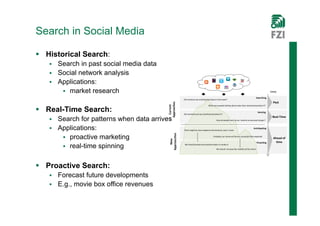


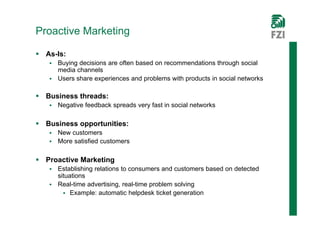





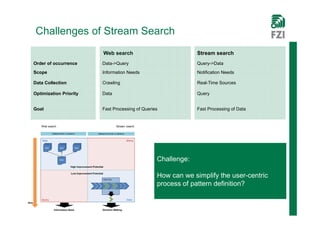

![Modeling Semantic Requests
Event pattern definition (Esper)
select * from UpdateEvent where content like „%apple%“ or content
like „%ipad%“ or content like „%iphone%“ or content like „%ios%“
Semantic request-enhanced pattern definition:
select * from UpdateEvent where sr:anythingRelated(content, like,
Company, [hasName:Apple]
Semantic requests:
sr:anything: Find any instances of a given concept
sr:anythingRelated: Find any related instances of a given concept
sr:all: Find all instances of a given concept
sr:allRelated: Find all related instances of a given concept
sr:geo: Find all related locations that are related to a given concept](https://image.slidesharecdn.com/ramss2012-final-120604093403-phpapp01/85/Using-Complex-Event-Processing-for-Modeling-Semantic-Requests-in-Real-Time-Social-Media-Monitoring-16-320.jpg)

